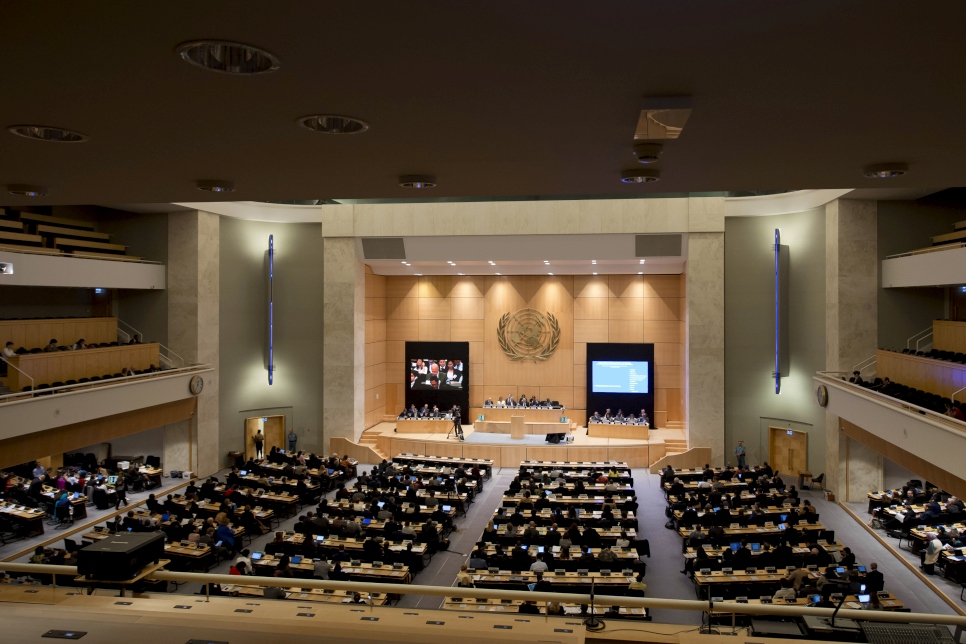ExCom plenary sessions
Executive Committee Bureau
The Executive Committee Bureau comprises four office holders: the Chairperson, two Vice-Chairpersons and the Rapporteur. The Bureau is elected at the end of the annual plenary session in October. By tradition, the chair is held in alternating years by donor and non-donor representatives.

Current officers
- Chairperson: H.E. Ambassador Ms. Rosemary MCCARNEY (Canada)
- 1st Vice-Chairperson: H.E. Ambassador Ms. Suraya DALIL (Afghanistan)
- 2nd Vice-Chairperson: H.E. Ambassador Mr. Boudjemâa DELMI (Algeria)
- Rapporteur: Ms. Anh Thu DUONG (Switzerland)
Executive Committee members
Executive Committee members and Standing Committee observers for the period October 2016 – October 2017
ExCom currently consists of 101 members.
How to apply for ExCom membership
The three explicit criteria for membership to be found in the General Assembly and ECOSOC resolutions that established the Executive Committee are:
• Demonstrated interest in and devotion to the solution of refugee problems
• Widest possible geographical representation
• Membership of the United Nations or its specialized agencies
When it was first established, the Executive Committee consisted of 25 members. With the increase in the volume and geographical spread of the activities of the Office to cover almost all regions of the world, ExCom membership has grown with successive resolutions of the General Assembly and ECOSOC.
- A State makes an application for admission to the Executive Committee of the High Commissioner’s Programme in writing, usually by note verbale, to the Secretary-General of the United Nations. In this note verbale, the State outlines its credentials for becoming a member of the Executive Committee in accordance with the criteria for membership to be found in the General Assembly and ECOSOC resolutions that established the Executive Committee, notably (a) demonstrated interest in and devotion to the solution of refugee problems (for example, adherence to the 1951 Convention and 1967 Protocol, as well as to any applicable regional instruments); (b) widest possible geographical representation; and (c) membership of the United Nations or its specialized agencies.
- This request is passed by the Secretary-General to ECOSOC.
- The requesting State submits a draft decision to the Secretary of ECOSOC, usually in July so it can be considered during the General Segment at ECOSOC’s substantive session under UNHCR’s agenda item.
- ECOSOC refers the matter to the General Assembly, requesting the Assembly to enlarge the number of Executive Committee members.
- The requesting State then submits a draft resolution to the Secretary of the Third Committee of the General Assembly (by the end of October at the latest).
- The General Assembly would then resolve to increase the number of slots available for membership in the Executive Committee. The Assembly refers the matter back to ECOSOC, requesting it to elect the members to fill the newly created slots.
- ECOSOC elects the State which has applied for membership to the Executive Committee.
Note: The process normally takes at least one to one and a half years.
Observers at the ExCom plenary sessions
The annual plenary session of the Executive Committee is open to all United Nations Member States. ExCom Member States are seated first, followed by all other UN Member States participating as observers to the session. The plenary session may also be attended by other entities that have received a standing invitation to participate as observers in the sessions and work of the General Assembly, including non-United Nations Member States, inter-governmental organizations, United Nations funds, programmes and specialized agencies, and non-governmental organizations (NGOs) with ECOSOC consultative status.
Following interventions by ExCom Member States, observers are normally given the right to speak, at the discretion of the ExCom Chairperson. However, observers do not have voting rights and are unable to participate in decision-making.

